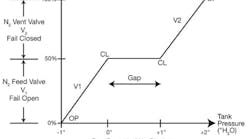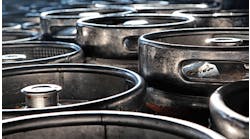“Ask the Experts” is moderated by Béla Lipták, process control consultant and editor of the Instrument Engineer’s Handbook (IEH). Preparation of the 5th edition of this three-volume handbook would require co-authors. If you’re interested in updating a complete chapter or a section within a chapter, send your resumé to [email protected].
Q: One of our process engineers has concerns about the standard split-range nitrogen blanketing on a vessel done with a DCS PID controller with separate analog outputs to each valve. I believe if everything is properly sized and tuned, there are no issues as he describes. What is your opinion?
There is only one output from the controller, and it’s “duplicated” and sent two places. The offset is in the function of the valves, and they are “downstream” from the controller so to speak.
The process engineer’s description of the behavior of the system is below:
Here is your feedback from the standard setup. I observed in the field the standard setup we discussed. The controller always sees an error and its output is responding. The output eventually calls for either more N2 or opening the vent and it cycles back. The controllers do not hang in the dead band of the output, but rather drift across from one side to the other. There is always an integration of the error to drive the error to zero. This drives a drift across the dead zone in the output to either add N2 or vent.
I watched a deadheaded Syltherm tank “huff and puff” (slowly and not a lot of N2 per puff, but a lot over time) whenever it rained or a cloud passed over. When the vapor space pressure dropped just a little, it added N2 back, and when it heated a little, it vented the excess pressure. All standard PID controllers will do this. The thought that the controller will hang in the dead band is just a thought. The controller cycles. The specific tank I observed was dead headed at 70 psig. There would be no impact on operations of the process if that tank cycled from say 65-75 psig. It controlled nicely and was wasting N2 for no benefit I can observe.
You are correct that this is an industry standard. That does not make it right! In many big operations, the operators will never notice, and the plants with produce what they are supposed to produce. The problem is they are dumping N2 (that costs money) to a vent, and often generating emissions at a cost with no benefit. My issue is good engineering and benefit for the client.
The fix is software and effectively no money. If I were the owner, this would be fixed ASAP. It is not my cost, so my interest is good engineering.
With respect to standards, every standard I have seen has a revision number on it and it is not often “Rev. 0.” We can do better.
Back to datasheets for me.
Scott H. DeYoung, PE
Shaw Energy & Chemicals Group
Michael Deady
Shaw Energy & Chemicals Group
A: Blanketing control is one of the applications where we use “gap control.” In gap control. the control algorithm is so configured that it considers the error to be zero as long as the measurement is within an acceptable gap that you set up around the set point. This way the split-ranged control valves will not cycle. Also, it is sufficient to have only a proportional mode in the controller. You do not need the integral.
You can read more about nitrogen blanketing and gap- based pressure control in Chapter 2.21 of the 4th edition of Volume 2 of the Instrument Engineer’s Handbook.
Naturally, your process engineer colleague should look into the possibility of eliminating nitrogen blanketing completely, because doing that will improve efficiency.
Béla Lipták
A: Gas blanketing is bad practice in general, and particularly bad for distillation columns. In addition to wasting nitrogen, which carries away product out the vent valve, it also decreases relative volatility, making distillation more difficult.
If it can’t be avoided, use a proportional controller with split-range valves. Pressure does not have to be held right at set point.
Greg Shinskey
A: Using an integral function, the system will likely behave as described. Why use it? Your controller probably has proportional with gap function which will allow the pressure to wander a little without opening either valve unnecessarily. Even pure proportional will work with offset between the zero signal on each output. One of the first rules of controller tuning is that two integrators will cause oscillatory response unless they are very different in time constant. Your flow into (or out of) a capacity provides one of the integrators. You don’t need the second one in the controller.
Ian H. Gibson, CPChem, RPEQ, FSEng
Process, Control and Safety Engineering Consultant
Victoria, Australia
A: Split range works fine when it is applied properly. If the operation engineer is suggesting the use of two different controllers, that tells me the control philosophy may need to be reviewed and the control strategy re-done in light of whatever the objective is pursued.
It looks to me like the operation engineer does not want N2 to be vented unnecessarily. However, he must understand that implementing two separate controllers or a split- range or a gap controller for the service he’s describing will always result in the limit cycling he illustrated.
Sigifredo “Sigfried” NINO
Invensys Systems Canada Inc.
Q: I would like to contribute to the next edition of the Instrument Engineers Handbook. I would like to know what are the formalities and what are the qualifications required. I am a design engineer working with a Danish oil and gas consultant. Please let me know how to proceed.
Deepesh G.K
Rambøll Oil & Gas
Doha - Qatar
A: I am glad that you are writing from outside the United States, because it is time for us to broaden the character of the Instrument Engineers’ Handbook (IEH) from an American to a global one, so that the readers can benefit from the knowledge of process control engineers around the globe.
In preparation for the 5th edition, I have a folder in which I am collecting the names and addresses of the potential co-authors, their areas of interests and their qualifications (resumés), including past publications if any. When somebody offers to update an existing chapter or prepare a new one, I favor colleagues with operating or design experience, because the IEH is written by users and for users, and therefore I want to keep it totally unbiased, which can be hard (although there are outstanding exceptions) for colleagues working for suppliers.
The IEH is a practical handbook. The dirtier its pages get, the happier I am. If you do not have copies of the index of the three volumes (Vol. 1 on measurement, Vol. 2 on control, Vol. 3 on software), I can send them to you. You can find a complete index to all three volumes at www.controlglobal.com/IEHindex.html. In the 5th edition, I plan to insert new material on energy conservation and on the control of renewable energy processes.
I should also note that I have not yet decided if I should take on the preparation of the 5th edition, and if I do, whether I should retain the three-volume format. One option I am thinking about is to find three competent colleagues, each to edit one of the volumes at my guidance as the series editor. Another option I am considering is to abandon the three-volume format and publish each chapter as a separate book. Therefore, when you send me your offer to participate, you have three options:
- You can offer to update or prepare section(s) in the 4th edition. If this is your preference, name the section(s) you would like to handle.
- If you are experienced as an editor (put information in your resumé), you can offer to take on the editing of one of the three present volumes.
- If you are qualified (please elaborate on this in your resumé), you can offer to take on the conversion of one of the chapters into a separate book by updating some of the sections by yourself, and inviting qualified coauthors to update the ones you are less knowledgeable about.
In view of the above, you can send me your resumé, and tell me what role you would like to play.
Béla Lipták



